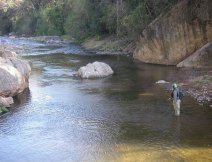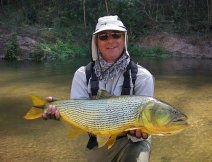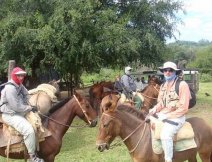The Rio Dorado is one of the healthiest rivers in the Yunga area hosting a huge population of Sabalo (Prochilodus lineatus), Boga (Leporinus obtusidens), and other baitfish.
Just a little northeast of Salta Argentina, the rain shadow of the Andean Mountains gives way to the Yunga forest. Here in the foothills of the high Andes the Rio Dorado and Rio de Valle are born. These rivers and Yunga forest surrounding them are one of the last great remote freshwater Dorado fisheries in the world. The head waters of these rivers are totally contained on a privately preserved 80,000 acre estancia. These rivers are protected and very remote with less than 60 anglers a year fishing the upper Rio Dorado. The upper reaches of these rivers are only accessible by horseback (the original all terrain vehicle).
The Rio Dorado is one of the healthiest rivers in the Yunga area hosting a huge population of Sabalo (Prochilodus lineatus), Boga (Leporinus obtusidens), and other baitfish. As far as game fish go there are a few catfish but the Dorado (Salminius Maxilosus) is king. It is not uncommon to witness 20-25 Dorado in a single pool. Because of the abundant food supple the average Dorado weighs 5-6 kilos (11-14 pounds) with fish exceeding 15 kilo in the river. However, the clear water requires an angler to make excellent presentations and a stealthy approach. The large fish of Rio Dorado are not easy in this clearwater environment. Also in this area are the Seco and Valle where you will find plenty of smaller Dorado.
The season on these three rivers is April and May and then September, October and November. Early June can be good also but is weather dependent. From December to late March the rivers are inaccessible due to the rainy season.
You will fish the rivers via daily horseback rides from two base camps set on the Rio Dorado. The Yungas forest surrounding the rivers is as wild as any place on earth. So be sure to bring your camera not that pictures will do it justice. You may encounter Mono Cai the native monkeys, Chancho Majano the wild native pigs or Tapir a very interesting looking animal that is almost prehistoric.
So if you are looking for the fishing adventure of a lifetime in a remote place that very few people will ever visit with the chance to catch the toughest of all freshwater fish then pack your bags and head to the Yungas of Northwest Argentina.
Salta City is your destination, a historical city with great restaurants to enjoy traditional northwestern Argentine cuisine and wines.
After breakfast you will depart for the Yungas and the clear water Dorado streams. A two hour drive to the ranch and you will be fishing the Rio del Valle for Dorado in the 2 to 5 k range. A base camp on the lower section of Dorado River allows you to fish the lower river and return in the evening to base camp for dinner, a traditional asado.
After fishing the lower section you need to take horses to reach the upper river camp at the "the Canyons". The " Canyons " provides the angler a chance for BIG Dorado lurking in every pool. By this time you are all charged up with adrenalin rushing on each cast. The angler by now has experienced the remoteness and beauty of the environs, the challenge and excitement of the stalk and that special high when a Dorado is solidly hooked and FISH ON takes on a whole new meaning!!
If any of the following appeal to you then experiencing the ' REEL DEAL ' should be on your fishing list:
o A fishing experience that few in the world will ever do.
o Fishing in trout like environs for aggressive fish on steroids.
o Stalking big fish and sight fishing.
o A truly memorable experience
The equipment.-
We would recommend you bring:
1 Long pants and long sleeve shirts, preferable drysec
2 Felt wading shoes or sandals and wading socks
3 A hat with mosquito mesh protection
4 Sun gloves
5 Sun screen lotion
6 Polarized sun glasses
7 Buzz Off or insect repellent
The fishing gear.-
We recommend you bring:
1 Fishing rods 9' #8 to #10 Wt.
2 Reel (saltwater reel with a good drag) with 200yds.of 30 pound test backing
3 Floating and sink tip lines (slow and fast sinking) good for tropical weather
4 Bimini leaders 9 feet long with 20 pound test tippet
5 Steel wire 20 pound test ( necessary to protect the leader from the sharp teeth of the Dorado )
6 Pliers to cut this wire
7 Maxima leader material 15/20/25/30/40 pound test.
Our flies and Fishing techniques.-
The Dorado is a natural hunter of smaller fish as this is his food chain. In a lot of circumstances the fish will adopt positions in the river similar to big trout feeding on baitfish. Ambush, attack and aggressiveness are the characteristics of Dorado on the prowl. The rivers of this area resemble the morphology of a trout river.
Depending on the water level and average temperatures we will fish the Dorado with floating lines or sinking lines in deeper pools. In both cases we will first spot the fish or blind cast to the imaginary position of the fish and then start covering the area where the Dorado is hunting. We will cast upstream and across letting the fly swim/drag across the current until it reaches the area of the Dorado where we can give little twitches to the fly letting the swing continue in front of but still a bit upstream of the Dorado. Pay attention and hold on it is all visual..
A key item in Dorado fishing is setting the hook on the strike. Our instinct is to raise the rod as in setting the hook for trout but keeping the rod down and just holding the rod and the fish as much as you can (without breaking the line) then progressively raise the rod during the first run of the dorado is necessary for successful hookups. If you pass this test you will have a good chance of landing this extremely combative fish.
Our typical fly is a big long deceiver made with ostrich fiber, peacock fiber and saddle feathers. These are long but light flies to which we often add an open and messy muddler head to move water and attract the fish. The typical length of these flies is between 4 to 6 inches. In some cases we add little pieces of bright crystal flash or flashabou. Some of the best color combinations are black in the head and orange in the body. Also black and green, all orange, all green, black and purple and yellow and green.
There is so little fishing done in this area that there is a lot more to be discovered about technique and fly selection. We are starting to discover that many traditional techniques can really be improved upon and major changes in fly selection during periods of clearwater selectivity may increase hookup rates. I will be monitoring some changes that we believe will be more effective to see if it really works in many river conditions.
Keep watching FFP for new reports.
















